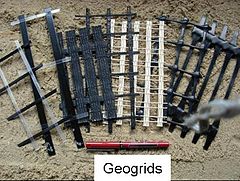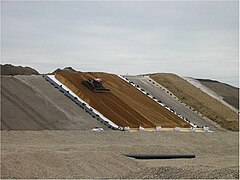

A geogrid is geosynthetic material used to reinforce soils and similar materials. Soils pull apart under tension. Compared to soil, geogrids are strong in tension. This fact allows them to transfer forces to a larger area of soil than would otherwise be the case.
Geogrids are commonly made of polymer materials, such as polyester, polyvinyl alcohol, polyethylene or polypropylene. They may be woven or knitted from yarns, heat-welded from strips of material, or produced by punching a regular pattern of holes in sheets of material, then stretched into a grid.
The development of methods of preparing relatively rigid polymeric materials by tensile drawing, in a sense "cold working," raised the possibility that such materials could be used in the reinforcement of soils for walls, steep slopes, roadway bases and foundation soils. The principal function of geogrids is for reinforcement. This area, as with many other geosynthetics, is very active, with a number of different products, materials, configurations, etc., making up today's geogrid market. The key feature of all geogrids is that the openings between the adjacent sets of longitudinal and transverse ribs, called “apertures,” are large enough to allow for soil strike-through from one side of the geogrid to the other. The ribs of some geogrids are often quite stiff compared to the fibers of geotextiles. As discussed later, not only is rib strength important, but junction strength is also important. The reason for this is that in anchorage situations the soil strike-through within the apertures bears against the transverse ribs, which transmits the load to the longitudinal ribs via the junctions. The junctions are, of course, where the longitudinal and transverse ribs meet and are connected. They are sometimes called “nodes”.
Currently there are three categories of geogrids. The first, and original, geogrids (called unitized or homogeneous types, or more commonly referred to as 'punched and drawn geogrids') were invented by Dr Frank Brian Mercer in the United Kingdom at Netlon, Ltd., and were brought in 1982 to North America by the Tensar Corporation. A conference in 1984 was helpful in bringing geogrids to the engineering design community. A similar type of drawn geogrid which originated in Italy by Tenax is also available, as are products by new manufacturers in Asia.
The second category of geogrids are more flexible, textile-like geogrids using bundles of polyethylene-coated polyester fibres as the reinforcing component. They were first developed by ICI Linear Composites LTD in the United Kingdom around 1980. This led to the development of polyester yarn geogrids made on textile weaving machinery. In this process hundreds of continuous fibers are gathered together to form yarns which are woven into longitudinal and transverse ribs with large open spaces between. The cross-overs are joined by knitting or intertwining before the entire unit is protected by a subsequent coating. Bitumen, latex, or PVC are the usual coating materials. Geosynthetics within this group are manufactured by many companies having various trademarked products. There are possibly as many as 25 companies manufacturing coated yarn-type polyester geogrids on a worldwide basis.
The third category of geogrids are made by laser or ultrasonically bonding together polyester or polypropylene rods or straps in a gridlike pattern. Two manufacturers currently make such geogrids.
The geogrid sector is extremely active not only in manufacturing new products, but also in providing significant technical information to aid the design engineer.
Ecological balance
Usually retaining walls are constructed of reinforced concrete, if an impermeable surface is not desired, it would be a sensible solution to create a filling area (but not for dam constructions). Choosing the ground reinforced with geogrid reinforcements instead of reinforced concrete retaining wall will also contribute to the ecological balance. While reinforced concrete wall surfaces cannot be vegetated, the surfaces of filled areas reinforced with geogrid reinforcements can be vegetated.
Applications of Geogrids
Geogrids are extensively utilised across a diverse range of civil engineering projects, spanning from power generation and soil stabilisation to erosion control and roadway improvement. In addressing the challenges inherent in land construction, geogrids emerge as a natural and cost-effective solution for subgrade development. Civil engineers must consider various factors depending on the land being developed. Some common applications of geogrids are:
Pavements
Geogrids have been effectively employed in pavement and roadway construction for the past two decades. Their applications include sub-grade improvement, reinforcing the base course, sub-base, and surface courses. By reinforcing pavements with geogrids, the outward displacement of railway ballast is arrested, and settlement is significantly reduced. This reinforcement is particularly beneficial in clayey compressive soils, as it enhances the California Bearing Ratio (CBR) of sub-grade soil composites. Stiffer geogrids demonstrate superior performance in soft sub-grade conditions compared to flexible geogrids, which tend to react quickly to applied loads.
Retaining walls
Main article: Retaining wallIn retaining wall applications, geogrids are utilised to stabilise the backfill material. The stability of earth-retaining walls is influenced by the friction angle, and the performance of geogrids is affected by their creep and stress relaxation properties. It is essential to ensure that the working stress does not exceed 40% of the geogrid's strength. High-strength geogrids should be placed in the middle of the retaining wall, or the spacing of the geogrid reinforcement should be reduced to enhance stability. This reinforcement helps increase the bearing and energy absorption capacities of the wall, particularly when dealing with marginal backfills.
Foundations in soft soil
Geogrids are crucial in foundation applications, particularly in soft soil conditions, where they provide the necessary stiffness and stability to act as reinforcement. Both uniaxial and biaxial geogrids are commonly used in foundation works. The effectiveness of geogrids in enhancing stability is largely dependent on their interlocking capacity with aggregates. Studies have shown that the bearing capacity of circular rigid foundations increases significantly with the use of geogrid reinforcement, especially when multiple layers are employed.
Slope stability
Main article: Slope stabilityGeogrids play a vital role in enhancing slope stability by influencing slope deformation and overall stability. Research indicates that the addition of geogrid reinforcement can improve load-settlement behavior and bearing capacity at selected locations within the slope. The effectiveness of geogrids in slopes is contingent upon factors such as length, edge distance, and particle size. While longer geogrids can increase costs, they also enhance the safety factor of earthen embankments by reducing displacement under loading conditions.
Concrete structures
In structural applications, geogrids serve as additional reinforcement and shear reinforcement, significantly improving the load-bearing capacity of concrete components. The use of fibers such as polypropylene and steel in conjunction with geogrids enhances strength and energy absorption while reducing slippage, shear, and bond strength. Geogrids are particularly effective in thin concrete layers and prefabricated structures, providing resistance to chemicals, corrosion, and temperature variations. Their incorporation into structural elements leads to improved overall performance and durability.
References
- Müller, W. W.; Saathoff, F. (2015). "Geosynthetics in geoenvironmental engineering". Science and Technology of Advanced Materials. 16 (3): 034605. Bibcode:2015STAdM..16c4605M. doi:10.1088/1468-6996/16/3/034605. PMC 5099829. PMID 27877792.
- Capaccio, G.; Ward, I. M. (1973). "Properties of Ultra-high Modulus Linear Polyethylenes". Nature Physical Science. 243 (130): 143. Bibcode:1973NPhS..243..143C. doi:10.1038/physci243143a0.
- Mercer, F.B. (1987) "Critical Aspects of Industrial and Academic Collaboration," The Philips Lecture, The Royal Society.
- Ward, I. M. (1984) “The Orientation of Polymers to Produce High Performance Materials” Proceedings of the Symposium on Polymer Grid Reinforcement in Civil Engineering, Institution of Civil Engineers, UK.
- Kırmızı, M. (2020). Stability of filling areas: example of The Çamlica mosque (Doctoral thesis, Istanbul Aydın University, Turkey).
- Applications_and_Performance_of_Geogrids_in_Structures